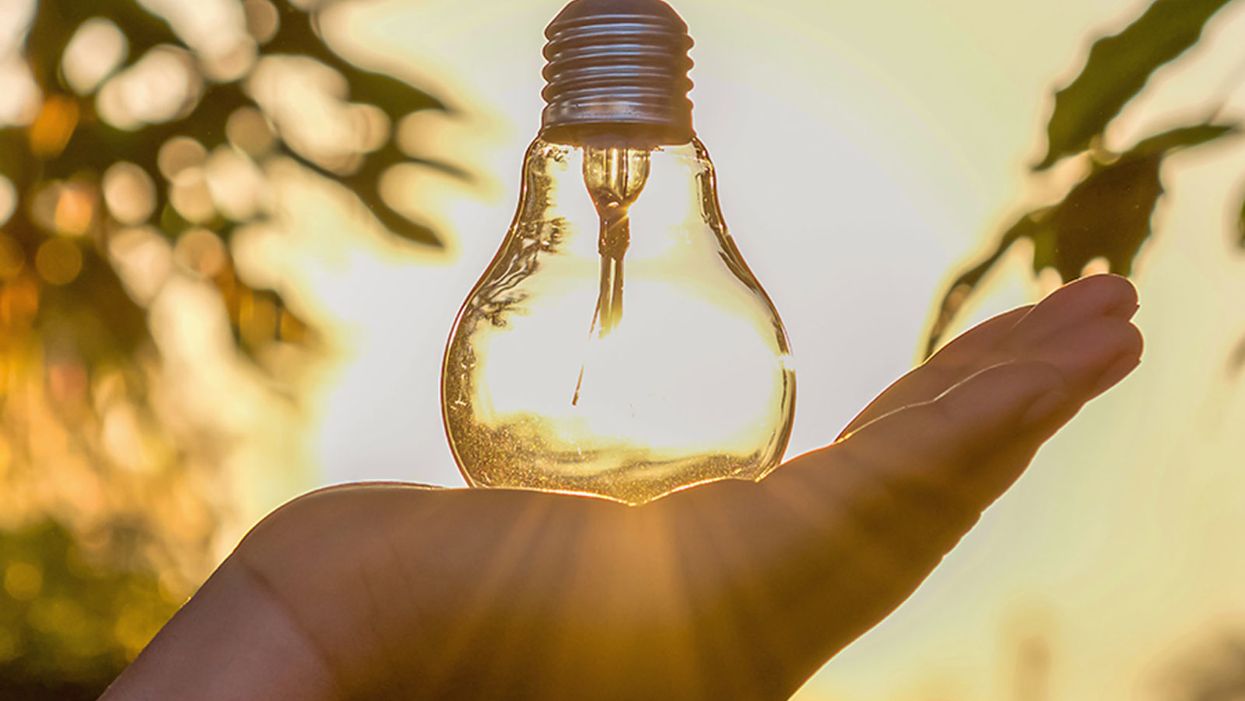Edible Silverware Is the Next Big Thing in Sustainable Eating
A new edible spoon is durable enough for mass market assembly and is already alleviating consumer waste.
Sure, you may bring a reusable straw when you go out to eat. But what about digesting your silverware at the restaurant? The future is already here.
Edible cutlery feels like a natural progression post-reusable straw.
Air New Zealand just added the new edible coffee cup Twiice into their in-flight service. Made from vanilla, wheat flower, sugar, egg and vanilla essence, the Twiice cups will be standard issue for the international airline.
On the ground, the new, award-winning startup IncrEDIBLESpoon has shipped more than a quarter million edible scoopers. The spoons are all-natural, vegan, and made from wheat, oat, corn, chickpea and barley.
The technological breakthrough is in creating tasty, mass-market material durable enough for delivery in an assembly line environment like airplane service, as well as stable enough to hold a hot cup of coffee or a freezing scoop of ice cream. Twiice cups can last several hours after hot coffee is added, while IncrEDIBLESpoon cutlery holds up to 45 minutes.
"We already caught the interest of a couple major ice cream chains," says Dinesh Tadepalli, co-founder of the IncrEDIBLESpoon parent company Planeteer. "If all goes well, one of them will test out our spoons at their scoop shop early this year."
Next Up
Edible cutlery feels like a natural progression post-reusable straw. And more is already on the menu.
The coffee cup company Twiice is already planning on expanding. Co-founder Jamie Cashmore says other serving items are coming later this year.
IncrEDIBLESpoon is also getting into more utensils. "We plan to mass produce the complete set by year's end: Edible straws, edible forks and edible coffee stirrers," Tadepalli says.
Most notably, Twiice's partner Air New Zealand sees the coffee cup as just a start to other sustainable solutions. The airline estimates it currently serves eight million cups of coffee annually. It's even suggesting customers bring their own reusable cup to the plane – though that isn't as ergonomic nor as attractive as eating everything you are served.
Open Questions
Making everything edible has a few challenges. First is cultural acceptance: With respect to current success, changing eating habits will require going beyond eco-focused and curious eaters.
Second, it's unclear if the short-term economics will add up in favor of airline carriers and other companies. Like alternative fuel, organizations will be more likely to adopt new science when it doesn't require a retrofitting or expensive change to their current business model – even if it does create long-term benefits.
The changes will likely be lopsided, influencing cultures at different times. Airplanes are a great start, as passengers are a captive audience interested in removing waste as soon as possible.
"Imagine eating a black pepper spoon after your soup or a chocolate spoon after your ice cream?"
We can expect edible cutlery to make an easier impact with certain cultures or foods. For instance, injera, the spongy Ethiopian bread, has served as an African plate of sorts for years. It makes sense that IncrEDIBLESpoon's four flavors, Salt, Masala, Spinach and Root, all fit in another bread-as-plate friendly culture: Indian.
Coffee and desserts sound like a good bet for now, though, especially for foodies. "People are curious to try edible spoons as they never heard or experienced them before," Tadepalli says. "Imagine eating a black pepper spoon after your soup or a chocolate spoon after your ice cream?"
Scientists Just Created Liquid Solar Power That Can Be Stored for 18 Years
A team of Swedish scientists has gathered solar power so pure, that until recently, capturing it was an impossibility.
Look no further than this week's climate strikes for evidence that millions of people are passionate about curbing global warming.
Unlike relatively limited solar panel energy storage, norbornadiene can potentially maintain its potency for years.
But even potential solutions, like alternative meats, have their own challenges. Some scientists are putting their focus on the sun to help balance out our energy consumption.
In fact, they are gathering solar power so pure that, until recently, capturing it was an impossibility.
The Lowdown
A group of Swedish scientists has created a liquid called norbornadiene. This liquid sunshine can capture up to 30 percent of raw solar power. To put it in perspective, the best publicly available solar panels can harness 21 percent. Norbornadiene would bring in about 50 percent more power – a significant difference in energy efficiency.
Most notably, unlike relatively limited solar panel energy storage, norbornadiene can potentially maintain its potency for years. We could have the ability to collect and store premium solar power, making it easier for current and future generations to use fossil and nuclear fuel alternatives.
"The norbornadiene molecules that we have made have very good properties, in terms of solar energy capture efficiency, storage time and energy density," says team lead Dr. Kasper Moth-Poulson of the Chamlers University of Technology. "They can store energy without the need for insulation materials for 18 or more years."
Next Up
Swedish scientist Moth-Poulsen and his team have been testing the norbornadiene on the physics building roof at the Chalmers University of Technology. Once activated, it heats up to just below boiling and provides enough power to be useful.
The energy density is 250 watt-hours per kilogram, twice the strength of Tesla's popular Powerall battery.
It requires potentially toxic solvents, like a cobalt-based activator, to transform into its full potential. The team is currently trying to find less-hazardous catalysts to help transform the norbornadiene to its active form, quadricyclane. Exposing it to sunlight is the main way to reactivate the norbornadiene's power. Over time, scientists will likely make it more efficient with less toxic agents.
The energy density is 250 watt-hours per kilogram, twice the strength of Tesla's popular Powerall battery.
Open Questions
The biggest question is safety, perceived or otherwise: Are you ready to drive around with 250 kWh of pure solar in your Hyundai? Norbornadiene may be stable in a hermetically sealed lab, but sculpting it for everyday use requires another level of security.
The half-life of the sunshine power is also an estimate, too. The challenge with new scientific substances is you don't know how the matter will evolve over time. It is easy to be overly optimistic about this one discovery being the key to our energy needs. For the time being, it is wiser to look at norbornadiene as a progressive step rather than a revolutionary one.
Even at its least effective, norbornadiene and its related material is a step toward us utilizing the one natural resource that won't run out for generations. In the short-term, a stable form of it could offset our fossil and nuclear fuel use and even help lower the carbon footprint made by long-distance transportation. It will be fascinating to see what future aircraft builders, home designers and even car manufacturers do as the solar technology conversation heats up.
Moth-Poulsen wants norbornadiene to be a definitive part of the climate change puzzle.
"I hope that in five years, we will see the first products based on our molecules and could help mitigate the daily variations in temperature," he says. "This will lead to increased thermal comfort and reduced energy consumption for heating and cooling."
Turning Algae Into Environmentally Friendly Fuel Just Got Faster and Smarter
Algae in the Mediterranean sea.
Was your favorite beach closed this summer? Algae blooms are becoming increasingly the reason to blame and, as the climate heats up, scientists say we can expect more of the warm water-loving blue-green algae to grow.
"We have removed a significant development barrier to make algal biofuel production more efficient and smarter."
Oddly enough, the pesky growth could help fuel our carbon-friendly options.
This year, the University of Utah scientists discovered a faster way to turn algae into fuel. Algae is filled with lipids that we can feed our energy-hungry diesel engines. The problem is extracting the lipids, which usually requires more energy to transform than the actual energy we'd get – not achieving what scientists call "energy parity."
But now, the University of Utah team has discovered a new mix that is more efficient and much faster. We can now extract more power from algae with less waste materials after the fact. Paper co-author Dr. Leonard Pease says, "We have removed a significant development barrier to make algal biofuel production more efficient and smarter. Our method puts us much closer to creating biofuels energy parity than we were before."
Next Up
Algae has a lot going for it as an alternative fuel source. It grows fast and easily, absorbs carbon dioxide, does not compete with food crops for land, and could produce up to 60 times more oil than standard land-based energy crops, according to the U.S. Department of Energy. Yet the costs of algal biofuel production are still expensive for now.
According to Science Daily, only about five percent of total primary energy use in the United States came from algae and other biomass forms. By making the process more efficient, America and other nations could potentially begin relying on more plentiful resources – which, ironically, are more common now because of climate change.
Algae fuel efficiency is already a proven concept. A decade ago, Continental Airlines completed a 90-minute Boeing 737-800 flight with one engine split between biofuel and aircraft fuel. The biofuel was straight from algae. (Other flights were done based on nut fuel and other alternative sources.) The commercial airplane required no modification to the engine and the biofuel itself exceeded the standards of traditional jet fuel.
The problem, as noted at the time, is that biofuels derived from algae had yet to be proven as "commercially competitive."
The University of Utah's discovery could mean cheaper processing. At this point, it is less about if it works and more about if it is a practical alternative.
However, it's unclear how long it will take for algae to become more mainstream, if ever.
Open Questions
Higher efficiency and simpler transformations could mean lower prices and more business access. However, it's unclear how long it will take for algae to become more mainstream, if ever. The algae biofuel worked great for a relatively sophisticated Boeing 737 engine, but your family car, the cross-country delivery trucks and other less powerful machines may need to be modified – and that means the industry-at-large would have to revise their products in order to support the change.
Future-focused groups are already looking at how algae can fuel our space programs, especially if it is more renewable, safe and, potentially, cheaper than our traditional fuel choices. But first, it is worth waiting and seeing if corporations and, later, citizens are willing to take the plunge.


